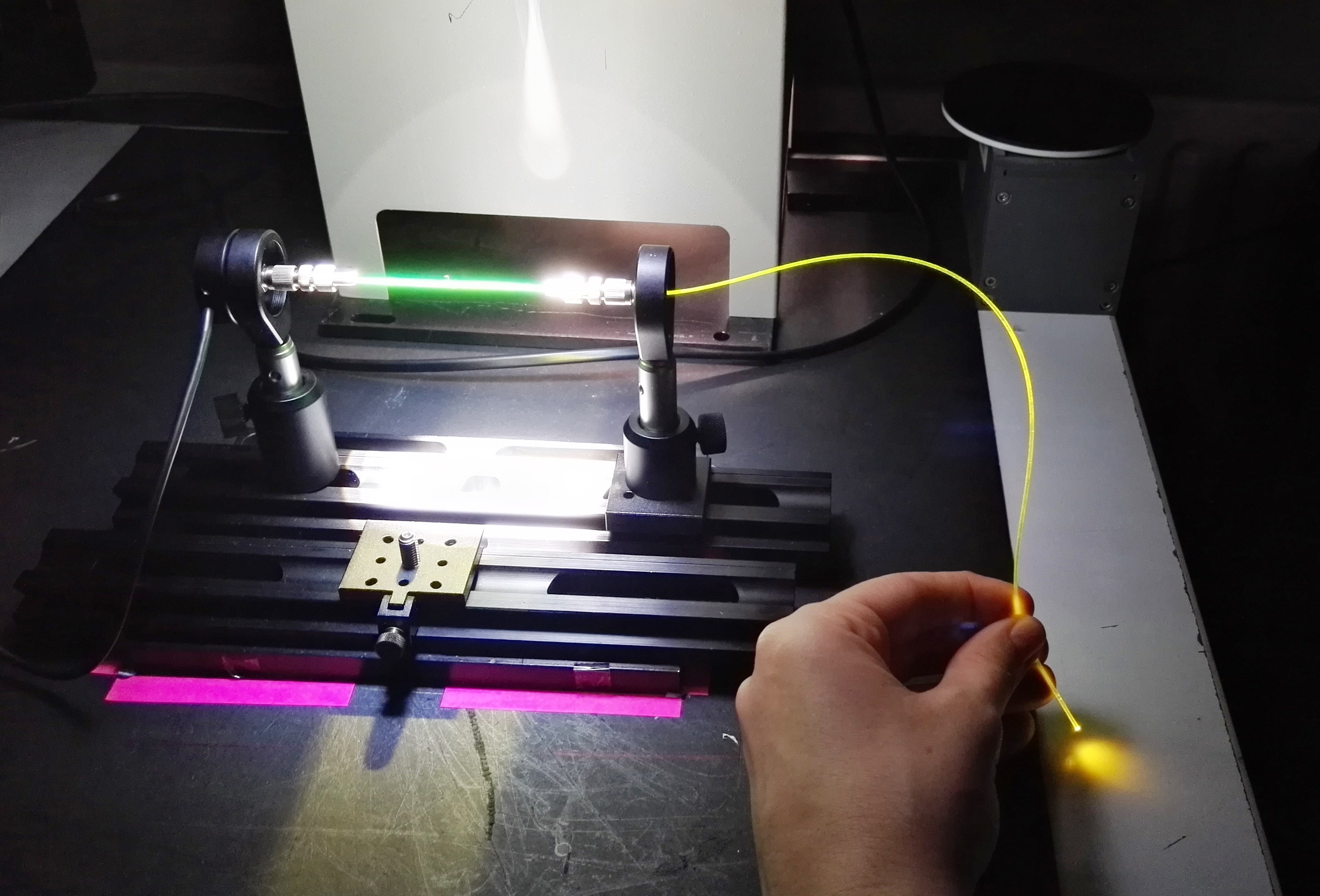A polymer optical fibre that acts as a luminescent solar concentrator, doped with a combination of hybrid dopants, has been fabricated by Itxaso Parola. It is the first time that a polymer optical fiber containing organic and inorganic components is used as a solar concentrator.
-

Ferreirak eta Bengoetxeak beren programak aurkeztu dituzte UPV/EHUko Klaustroan
-

UPV/EHUko 19 diziplina, munduko 500 onenen artean, Shanghaiko rankingaren arabera
-

Zientzia, Ingeniaritza eta Arkitekturako monografiarik onena
-

Medikuntza birsortzailearen etorkizunari buruzko gakoak
-

Beste pertsona bat al gara beste hizkuntza bat hitz egitean?
New high-performance polymer optical fibre designed to obtain solar energy
The UPV/EHU-University of the Basque Country has fabricated a polymer optical fibre doped with a hybrid combination of dopants that concentrates sunlight with high performance and in a cost-effective way
- Research
First publication date: 28/03/2018

Results of the measurements reveal that its performance is high in terms of sunlight concentrating and transporting capability, and that it is a highly suitable material for powering small devices when attached to photovoltaic cells.
Despite the fact that in 2017 only 3% of the energy consumed came from wind, sunlight and biomass, experts believe that photovoltaic technology has the largest growth prospects. Indeed, solar energy is an inexhaustible energy source, and can be obtained not only from solar farms but also by means of smaller devices integrated in houses, on rooftops and in many other places.
Numerous pieces of research are being conducted across the world to improve photovoltaic solar cells; until now the most suitable photovoltaic cells produced have been silicon solar cells, but there are still many aspects that need to be improved: silicon sources are limited, large installation areas are needed, systems for tracking the sun are needed, they need direct sunlight, their performance falls considerably on cloudy days and in diffuse light conditions, etc. At the end of the day, obtaining solar energy remains expensive.
In fact, in a piece of research conducted in collaboration with the Applied Organic Materials Group of the Braunschweig University of Technology, the UPV/EHU’s Departments of Applied Physics I and Communications Engineering have fabricated a polymer optical fibre with a hybrid combination of dopants which offers the possibility of producing energy on a small scale. More precisely, to improve the features of the optical fibre, a mixture of dopants comprising organic and inorganic components was added to the polymer. “It has a great potential for power-supplying small devices or sensors when attached to photovoltaic cells, and could have huge marketing prospective for buildings integrated photovoltaics or the so-called green buildings,” said Itxaso Parola, author of the research. “What is more, they can easily be attached to passive optical fibres for transporting sunlight from one end of the fibre to the other, what permits powering devices a long way from the sun energy source.”
Cheaper than a large silicon-based cell surface
“The hybrid polymer optical fibre acts as a luminescent solar concentrator: it absorbs sunlight and emits it in higher wavelengths; the light is transported to the end of the optical fibre by total internal reflection, where photovoltaic cells are attached,” explained Parola. “This is the first time that a polymer optical fibre that combines organic and inorganic dopants is used for this purpose.” The UPV/EHU researcher also stresses that, like all luminescent concentrators, this one is also highly suitable for obtaining solar energy in shady spots in cities and on cloudy days.
According to the measurements made, they saw that a single 6 cm long fibre can concentrate sunlight with an intensity equivalent to one third of the light produced by the sun on a sunny summer’s day, “and this is a very good piece of data,” in the researcher’s view. The performance of the fibre was measured under many conditions of light and atmosphere, and “we found that the performance was good in all cases, even slightly better for diffuse light conditions. That is in fact very appropriate, because the performance of silicon cells is very low on cloudy days or under diffuse light scenarios”, she said. Even though the researcher admitted that when the fibre is very long, the light carried through the fibre weakens, “with a single fibre 6 metres long we managed to concentrate 1.3 greater intensity than what would be obtained with direct sunlight”, she said.
As the researcher pointed out, it is much cheaper to build such systems than to use larger silicon cell areas. In any case, she pointed out that they have to conduct further research on this subject to shed light on various key questions: “We have conducted tests using one fibre, but we would need a bundle of fibres to connect to photovoltaic cells. On the other hand, the surface area of photovoltaic cells is commonly square, and when this area is covered with cylindrical fibres, there will always be some small areas that receive no light. Right now, we are conducting tests involving changing the fibre’s diameter; when the fibre is thicker, it loses flexibility but at the same time it absorbs more light. We still have many things to explore, but the results are very promising”.
Additional information
Itxaso Parola (Plentzia, 1991) is a telecommunications engineer and is writing up her PhD thesis under the supervision of María Asunción Illarramendi of the UPV/EHU’s Faculty of Engineering, and Joseba Zubia of the department of Communications Engineering. She produced this work on a research internship at the Technische Universität Braunschweig in Germany under the supervision of Hans-Hermann Johannes. Various institutions are funding this research: the European Regional Development Fund (ERDF), the Spanish Ministry of the Economy and Competitiveness, the Basque Government’s Department of Education, Language Planning and Culture, ELKARTEK.
Bibliographic reference
- High performance fluorescent fiber solar concentrators employing double‐doped polymer optical fibers
- Solar Energy Materials and Solar Cells.
- DOI: 10.1016/j.solmat.2018.01.013




